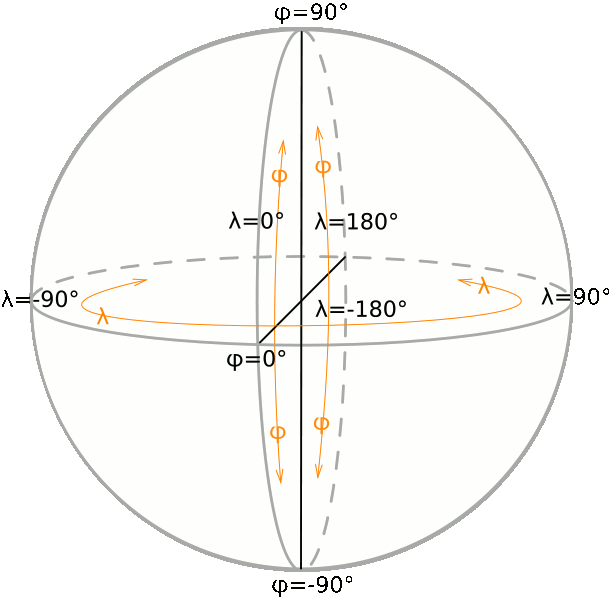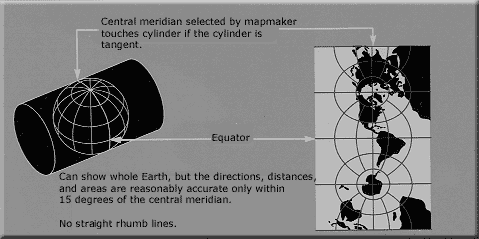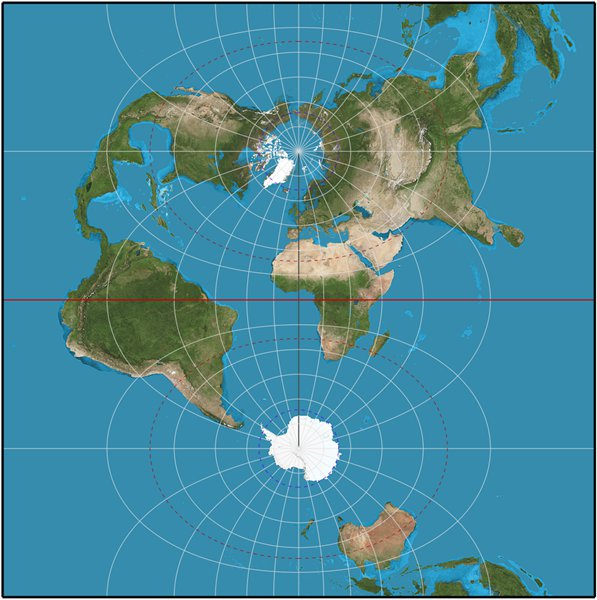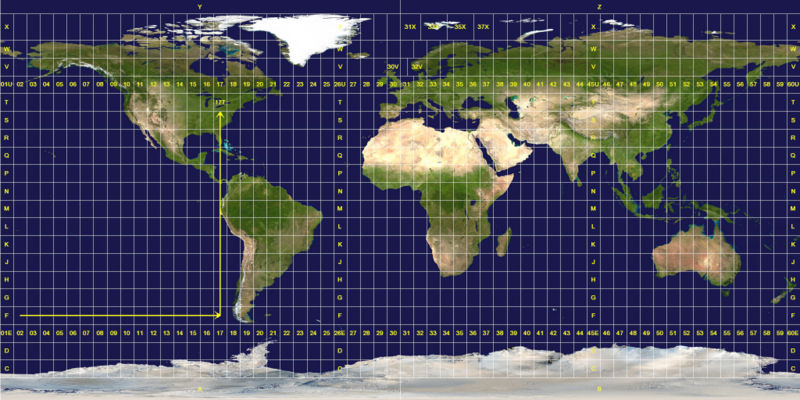|
What's this SRID stuff ? ... I've never heard this term before now ...
Planet Earth is a sphere ... not
exactly, planet Earth has an ellipsoidal shape (slightly
flattened at poles) ...
oh no, that's absolutely wrong: planet Earth
hasn't a geometric regular shape, it actually is a geoid
All the above assertions can be assumed to be true, but at different
approximation levels.
Near the Equator differences between a sphere and an ellipsoid are
rather slight and quite unnoticeable; but neat both Poles such
differences becomes greater and most easily appreciable.
For many practical purposes differences between an ellipsoid and a
geoid are very slim: but for long range aircraft navigation (or
even worse, for satellite positioning), this is too much
simplistic and unacceptably approximate.

Anyway, whatsoever could be the real shape of the Earth, position of each
point on the planet surface can precisely determined simply
measuring two angles: longitude and latitude.
In order to set a complete Spatial Reference System [aka SRS]
we can use the Poles and the Equator (which after all are
outstanding places by intrinsic astronomic properties):
choosing a Prime Meridian on the other side is absolutely
conventional: but since many centuries (Britannia rule the
waves ...) adopting the Greenwich Meridian is an obvious
choice.
Any SRS based on long-lat coordinates is known as a Geographic
System.
Using a Geographic SRS surely grants you maximum precision and accuracy:
but unhappily this fatally implies several undesirable
side-effects:
- paper sheets (and monitor screens) are absolutely flat; they
don't look at all like a sphere
- using angles makes measuring distances and areas really difficult and
counter-intuitive.
So since many centuries cartographers invented several (conventional)
systems enabling to represent spherical surfaces into a flatten
plane: none of them all is the best one.
All them introduce some degree of approximation and deformation: choosing
the one or the other implies an absolutely arbitrary and
conventional process: a map projection good to represent
small Earth's portions can easily be awful when used to represent
very wide territories, and vice versa.
We'll quickly examine the UTM [Universal Transverse Mercator]
map projection, simply because it's really often used.


Apparently this map projection introduces severe and not acceptable
deformations: but when you carefully focus your attention on the
narrow central fuse, you'll immediately recognize that UTM allows
to get a nearly perfect planar projection of excellent quality.
Anyway all this has a price: the central fuse has to be really narrow
(let say, it will span only few degrees on both sides). As the
fuse becomes wider, as much more deformations will become stronger
and more evident.

Accordingly to all the above considerations, UTM defines 60 standard zones,
each one covering exactly 6 longitude degrees.
Merging together two adjacent fuses (12 degrees) obviously reduces
accuracy, but is still acceptable for many practical purposes:
exceeding this limit produces really low-quality results, and has
to be absolutely avoided.
Attempting
to standardize the chaos
During the past two centuries every National State has introduced at
least one (and very often, more than one) map projection system
and related SRS: the overall result is absolutely chaotic (and
really painful to be handled).
Happily, an international standard is widely adopted so to make easier
correctly handling map SRS: the European Petroleum Survey Group
[EPSG] maintains a huge worldwide dataset of more
than 3,700 different entries.
Many of them are nowadays obsolete, and simply play a historical role;
many others are only useful in very limited national boundaries.
Anyway, this one is an absolutely impressive collection.
And each single entry within the EPSG dataset is uniquely identified
by its numeric ID and descriptive name, so to avoid
any possible confusion and ambiguity.
Any Spatial DBMS requires some SRID-value to be specified for
each Geometry: but such SRID simply is a Spatial Reference
ID, and (hopefully) coincides with the
corresponding EPSG ID
Just in order to help you understand better this SRID chaos, this is
a quite complete list of SRIDs often used in a (small)
Nation such as Italy:
| EPSG SRID |
Name |
Notes |
| 4326 |
WGS 84 |
Geographic [long-lat]; worldwide; used by GPS devices |
3003
3004 |
Monte Mario / Italy zone 1
Monte Mario / Italy zone 2 |
obsolete (1940) but still commonly used |
23032
23033 |
ED50 / UTM zone 32N
ED50 / UTM zone 33N |
superseded and rarely used: European Datum 1950 |
32632
32633 |
WGS 84 / UTM zone 32N
WGS 84 / UTM zone 33N |
WGS84, adopting the planar UTM projection |
25832
25833 |
ETRS89 / UTM zone 32N
ETRS89 / UTM zone 33N |
enhanced evolution of WGS84: official EU standard |
And the following examples may help to understand even better:
| Town |
SRID |
Coordinates |
| X (longitude) |
Y (latitude) |
| Roma |
4326 |
12.483900 |
41.894740 |
| 3003 |
1789036.071860 |
4644043.280244 |
| 23032 |
789036.071860 |
4644043.280244 |
| 32632 |
789022.867800 |
4643960.982152 |
| 25832 |
789022.867802 |
4643960.982036 |
| Milano |
4326 |
9.189510 |
45.464270 |
| 3003 |
1514815.861095 |
5034638.873050 |
| 23032 |
514815.861095 |
5034638.873050 |
| 32632 |
514815.171223 |
5034544.482565 |
| 25832 |
514815.171223 |
5034544.482445 |
As you can easily notice:
- WGS84 [4326] coordinates are expressed in decimal degrees,
because this one is a Geographic System directly based on long-lat angles.
- on the other side any other system adopts coordinates expressed in meters:
all them are projected aka planar systems.
- Y-values look very similar for every planar SRS: that's not surprising,
because this value simply represents the distance from the Equator.
- X-values are more dispersed, because different SRSes adopt different
false easting origins: i.e. they place their Prime Meridian in different
(conventional) places.
- Anyway, any UTM-based SRS gives very closely related values, simply
because all them share the same UTM zone 32 definition.
- The (small) differences you can notice about different UTM-based SRSes can be
easily explained: UTM zone 32 is always the same, but the
underlying ellipsoid changes each time.
Getting a precise measure for ellipsoid's axes isn't an easy task: and obviously during the time several
increasingly better and most accurate estimates has been progressively adopted.
Distance intercurring between
Roma and Milano
|
| SRID |
Calculated Distance |
| 4326 |
4.857422 |
| 3003 |
477243.796305 |
| 23032 |
477243.796305 |
| 32632 |
477226.708868 |
| 25832 |
477226.708866 |
| Great Circle |
477109.583358 |
| Geodesic |
477245.299993 |
And now we can examine how using different SRSes affects distances:
- Using WGS84 [4326] geographic, long-lat coordinates we'll actually get a measure corresponding to an
angle expressed in decimal degrees. [not so useful, really ...]
- any other SRS will return a distance measure expressed in meters:
anyway, as you can easily notice, figures aren't exactly the same.
- Great Circle distances are calculated assuming that the Earth is exactly a
sphere: and this one obviously is the worst estimate we can get.
- on the other side Geodesic distances are directly calculated on the reference Ellipsoid.
Conclusion:: Thou shall not have exact measures
But this isn't at all surprising in physical and natural sciences: any
measured value is intrinsically affected by errors and
approximations.
And any calculated value will be inexorably affected by rounding and
truncation artifacts.
So absolutely exact figures simply doesn't exist in the real world:
you have to be conscious that you can simply get some more or less
approximated value.
But at least, you can take care to properly reduce such approximations
in the best possible way.
|



